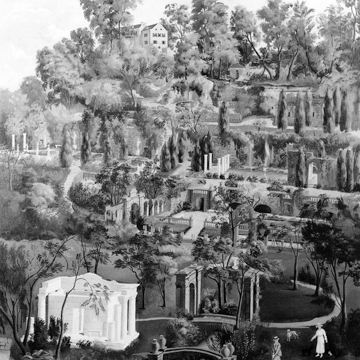Having declared his profession as “botaniste” on his traveling papers, E. I. du Pont lost no time in having seeds and plants sent from France, including fruit trees and grape vines. His garden (uphill from the house) later vanished, but garden archaeology, one of the first such endeavors in the United States, was begun in 1968. A sketch (c. 1870) by architect Theophilus P. Chandler allowed reconstruction of the pump of 1817. Visitors can study recreated eighteenth-century French garden treatments, including espalier. Near the garden stand several fine trees, including the second-largest Osage orange in the United States and a buckeye thought to have been hybridized by E. I. himself. The Crowninshields established a garden of their own downhill from the house, of entirely different character, an Italian ruin garden on the steep slope. They razed the upper stories of an abandoned saltpeter refinery there and built whimsical brick ruins, designed by Francis, with plantings by Louise. Huge saltpeter kettles of iron served as urns. This ruin garden has been partly razed.
You are here
Eleutherian Mills Gardens
1803. 1972 recreated, William H. Frederick Jr. 1924–1938 Italian classical garden, Francis B. and Louise du Pont Crowninshield
If SAH Archipedia has been useful to you, please consider supporting it.
SAH Archipedia tells the story of the United States through its buildings, landscapes, and cities. This freely available resource empowers the public with authoritative knowledge that deepens their understanding and appreciation of the built environment. But the Society of Architectural Historians, which created SAH Archipedia with University of Virginia Press, needs your support to maintain the high-caliber research, writing, photography, cartography, editing, design, and programming that make SAH Archipedia a trusted online resource available to all who value the history of place, heritage tourism, and learning.


